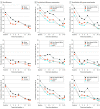Prevalence, Comorbidity, and Continuity of Psychiatric Disorders in a 15-Year Longitudinal Study of Youths Involved in the Juvenile Justice System
- PMID: 33818599
- PMCID: PMC8022269
- DOI: 10.1001/jamapediatrics.2020.5807
Prevalence, Comorbidity, and Continuity of Psychiatric Disorders in a 15-Year Longitudinal Study of Youths Involved in the Juvenile Justice System
Abstract
Importance: Previous studies have found that one-half to three-quarters of youths detained in juvenile justice facilities have 1 or more psychiatric disorders. Little is known about the course of their disorders as they age.
Objective: To examine the prevalence, comorbidity, and continuity of 13 psychiatric disorders among youths detained in a juvenile justice facility during the 15 years after detention up to a median age of 31 years, with a focus on sex and racial/ethnic differences.
Design, setting, and participants: The Northwestern Juvenile Project is a longitudinal cohort study of health needs and outcomes of 1829 randomly selected youths in a temporary juvenile detention center in Cook County, Illinois. Youths aged 10 to 18 years were interviewed in detention from November 20, 1995, through June 14, 1998. Participants were reinterviewed up to 12 times during the 15-year study period through February 2015, for a total of 16 372 interviews. The sample was stratified by sex, race/ethnicity (Black, Hispanic, and non-Hispanic White), age (10-13 years or 14-18 years), and legal status (processed in juvenile or adult court). Data analysis was conducted from February 2014, when data preparation began, to March 2020.
Exposures: Detention in a juvenile justice facility.
Main outcomes and measures: Psychiatric disorders, assessed by the Diagnostic Interview Schedule for Children, version 2.3 at the baseline interviews. Follow-up interviews were conducted using the Diagnostic Interview Schedule for Children, version IV; the Diagnostic Interview Schedule, version IV; and the World Mental Health Composite International Diagnostic Interview (beginning at the 6-year follow-up interview).
Results: The study included 1829 youths sampled at baseline (1172 males and 657 females; mean [SD] age, 14.9 [1.4] years). Although prevalence and comorbidity of psychiatric disorders decreased as the 1829 participants aged, 52.3% of males and 30.9% of females had at least 1 or more psychiatric disorders 15 years postdetention. Among participants with a disorder at baseline, 64.3% of males and 34.8% of females had a disorder 15 years later. Compared with females, males had 3.37 times the odds of persisting with a psychiatric disorder 15 years after baseline (95% CI, 1.79-6.35). Compared with Black participants and Hispanic participants, non-Hispanic White participants had 1.6 times the odds of behavioral disorders (odds ratio, 1.56; 95% CI, 1.27-1.91 and odds ratio, 1.59; 95% CI, 1.23-2.05, respectively) and greater than 1.3 times the odds of substance use disorders (odds ratio, 1.90; 95% CI, 1.55-2.33 and odds ratio, 1.39; 95% CI, 1.11-1.73, respectively) throughout the follow-up period. Behavioral disorders and substance use disorders were the most prevalent 15 years after detention.
Conclusions and relevance: This study's findings suggest that persistent psychiatric disorders may complicate the transition from adolescence to adulthood, which is already challenging for youths involved in the juvenile justice system, many of whom are from racial/ethnic minority groups and low-income backgrounds. The pediatric health community should advocate for early identification and treatment of disorders among youths in the justice system.
Conflict of interest statement
Figures





Comment in
-
The Importance of Longitudinal Treatment Engagement for Youths in the Juvenile Justice System.JAMA Pediatr. 2021 Jul 1;175(7):e205820. doi: 10.1001/jamapediatrics.2020.5820. Epub 2021 Jul 6. JAMA Pediatr. 2021. PMID: 33818585 No abstract available.
References
Publication types
MeSH terms
Grants and funding
LinkOut - more resources
Full Text Sources
Other Literature Sources
Medical

